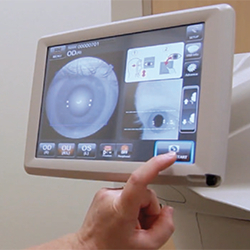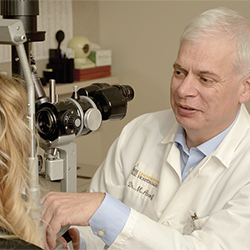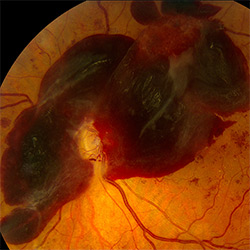
By Dawn Goodlove,
editor of Medicine Iowa,
from the fall 2018 issue
 The patient was an artist, so while he waited for his scheduled appointment in the ophthalmology clinic he sketched the faces of the other patients in the room.
The patient was an artist, so while he waited for his scheduled appointment in the ophthalmology clinic he sketched the faces of the other patients in the room.
When the time came for his exam, he shared his drawing with the doctor, a resident physician at the University Hospital of Utrecht, Netherlands.
“He had diabetes, and by the time he came in for an appointment there was permanent damage. He had diabetic macular edema,” says Michael Abràmoff, MD, PhD, the Robert C. Watzke Professor of Ophthalmology and Visual Sciences with University of Iowa Health Care, remembering that patient 21 years ago.
Diabetic macular edema is a consequence of diabetic retinopathy, specifically swelling of the macula that causes blurry vision. Early detection and treatment of diabetic retinopathy can reduce the risk of blindness by 95 percent, but because the condition lacks early symptoms, patients need regular exams by a retinal specialist.
Appointments in the Utrecht ophthalmology clinic were scheduled six months out in 1997. Of the patients with diabetes who came to the clinic, many had nothing wrong after screening exams. Abràmoff was frustrated that he wasn’t seeing the patients who needed help, nor seeing patients with diabetic retinopathy soon enough for effective treatment.
“I had a software background, and I thought, ‘We need to use computers to make this better,’” he says.
 Ophthalmologist with computer science expertise
Ophthalmologist with computer science expertise
For the last 20 years, Michael Abràmoff has studied how artificial intelligence (AI) can be used to detect disease in medical images—specifically how to use “smart cameras” enhanced with AI algorithms to detect signs of diabetic retinopathy.
 AI in health care
AI in health care
“Health care is an industry where there is a critical shortage of key talent, including medical assistants, nurses, and physicians,” says Maia Hightower, MD, MBA, MPH, chief medical information officer for UI Health Care. “AI helps to detect both operational and clinical high-risk areas so that limited resources can be targeted to areas of highest need or greatest return.”
 Running IDx through its trials
Running IDx through its trials
In 2017, IDx funded a clinical trial that compared the performance of IDx-DR to the gold standard diagnostic for diabetic retinopathy. It was the first study to prospectively assess the safety of an autonomous AI system in patient care.
 AI not replacing doctor
AI not replacing doctor
Two months after FDA authorization, IDx-DR made its debut at the Diabetes and Endocrinology Center at UI Health Care–Iowa River Landing in Coralville, Iowa. The clinic has approximately 7,200 diabetes and endocrinology patient visits each year. IDx-DR has increased the clinic’s ability and confidence to assess patients for complications of diabetes and refer them to a retinal specialist if needed.
 About diabetic retinopathy
About diabetic retinopathy
Diabetic retinopathy is the most prevalent cause of blindness and vision loss in people under age 75. Over time, diabetes damages blood vessels in the retina, the inner lining at the back of the eye.
 An IDx-DR timeline
An IDx-DR timeline
The development off IDx-DR begins its University of Iowa roots in 2004, the year Michael Abràmoff joins the Carver College of Medicine faculty.
More to explore
- Abràmoff MD, Folk JC, Han DP, Walker JD, Williams DF, Russell SR, Massin P, Cochener B, Gain P, Tang L, Lamard M, Moga DC, Quellec G, Niemeijer M. Automated analysis of retinal images for detection of referable diabetic retinopathy. JAMA Ophthalmol, 2013; 131(3):351-357. [PMID 23494039]
- Abràmoff MD, Lou Y, Erginay A, Clarida W, Amelon R, Folk JC, Niemeijer M. Improved automated detection of diabetic retinopathy on a publicly available dataset through integration of deep learning. Invest Ophthalmol Vis Sci. 2016; 57(13):5200-6. Epub 2016/10/05 [PMID: 27701631]
- Abràmoff MD, Lavin PT, Birch M, Shah N, Folk JC. Pivotal trial of an autonomous AI-based diagnostic system for detection of diabetic retinopathy in primary care offices. Aug 2018. Nature Digital Medicine. Doi: 10.1038/s41746-018-0040-6